Paskhas
| Korps Pasukan Khas "Paskhas" | |
|---|---|
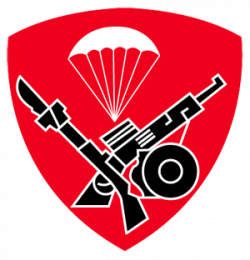 Paskhas Corps Insignia | |
| Active | 17 October 1947 – present |
| Country | Indonesia |
| Branch | TNI-AU (Indonesian Air Force) |
| Type | Air force infantry and special forces |
| Role |
|
| Part of | Indonesian National Armed Forces Tentara Nasional Indonesia (TNI) |
| Garrison/HQ | Margahayu, Bandung |
| Nickname(s) | Baret Jingga (Orange Berets), Hantu Udara (Ghost of the Skies), Komando |
| Motto(s) |
Karmaye Vadikaraste Mafalesu Kadacana ("Working without counting gains and losses"), Bhagavad Gita 2:47 |
| Beret colour | Orange |
| Engagements |
Indonesian National Revolution Republic of South Maluku rebellion Darul Islam Rebellion PRRI and Permesta rebellion Operation Trikora Indonesia–Malaysia confrontation Operation Seroja |
| Commanders | |
| Current commander | Air Vice Marshal Theodorus Seto Purnomo |
| Vice Commander | Air Commodore Yudi Bustami |
| Insignia | |
| Right Shoulder Patch |
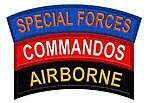 |
| Left Shoulder Patch |
 |
Paskhas (Indonesian: Korps Pasukan Khas) is the air force infantry and special forces corps of the Indonesian Air Force ("TNI-AU"). The corps is also known as the Orange Berets (Baret Jingga in Indonesian) because of their distinctive colour of their service headgear. Paskhas is trained to seize and defend airfields from enemy forces known as Operasi Pembentukan dan Pengoperasian Pangkalan Udara Depan (OP 3 UD) (Frontline Air Base Establishment and Management Operation), airborne operations, and other specific military operations within the scope of the Indonesian Air Force.
Paskhas is tasked with fostering the strength and ability of being as an air force unit to be ready for operations in carrying out the objectives and defense of strategic objects of the Air Force, air defense, special operations and other typical military operations under the policy of the TNI chief Commander. Paskhas has many air-oriented combat abilities, such as combat-control team, airfields control and defense, combat search and rescue, Jumpmaster, airborne, ground-forward air control and High-altitude military parachuting. They also can operate as Air Traffic Controllers (ATC) in certain situations.
Paskhas has a special unit tasked for conducting special operations such as responding to Aircraft hijacking and other specific missions tasked to the corps, the unit is known as the Bravo Detachment 90 (Satbravo 90).
History
The history of Paskhas as the first airborne troops is almost as old as the Republic of Indonesia. On 12 February 1946 the first parachute jump of the nascent Indonesian National Armed Forces was performed at the Maguwo Air Force Base in Yogyakarta by 3 people who jumped in the presence of the Commander of the Armed Forces Sudirman and the first Chief of Staff of the Air Force, Air Commodore Suryadi Suryadarma: Amir Hamzah, Iswahyudi and Pungut, all 3 having jumped from a converted Japanese transport aircraft. On 8 March 1947, with President Sukarno, Vice President Mohammad Hatta and defense officials in attendance, the 1st free fall jump was executed by Flight Lieutenants Sudyono and Soekotjo at the very same airfield. These jumps by personnel of the then Pasukan Pertahanan Pangkalan (PPP) (Air Field Defence Troops) would become the precursor for their baptism of fire. The PPP, raised in October 1945, months before the formal founding of the Air Force on 9 April 1946, was an active part in the defense of Republic-held air force bases.
First Airborne Operations
The then republican Governor of Kalimantan Ir. Prince Muhammad Noor made a request to the Indonesian Air Force to send paratroopers to Kalimantan for the task of forming and organizing pro-Republic guerrilla organizations to assist in the revolution in Borneo, opening a parent radio station to allow connections between Yogyakarta and Borneo rebels and selecting more dropping zones for future operations. At the initiative of the Chief of Staff of the Air Force, 12 indigenous sons of Kalimantan and 2 regular Air Force personnel were chosen.[1]
On 17 October 1947, thirteen airmen were successfully deployed in Sambi, West Kotawaringin, Central Kalimantan. They were Hari Hadi Sumantri (Semarang Radio Air Force mechanic), FM Soejoto (An Air Force Radio interpreter from Ponorogo), Iskandar (troop leader), Ahmad Kosasih, Bachri, J. Bitak, C. Williem, Imanuel, Amirudin, Ali Akbar, M Dahlan, JH. Darius, and Marawi. All of these brave men (save for one airman named Jamhani who did not jump because he was scared) were never taught and trained formal airborne exercises except of theoretical and simple ground training.
They were deployed from the C-47 Dakota RI-002 aircraft flown by an American named Bob Freeberg as well as the owner of the aircraft, co-pilot Warrant Officer Suhodo, and the Jumpmaster, Pilot Officer Amir Hamzah. Acting as the pointer to the parapet was Major Tjilik Riwut who was a native son of Borneo. This was the first airborne operation in Indonesian history.
The troops would initially be deployed in Sepanbiha, South Kalimantan, but due to bad weather and the contours of the heavily forested areas of Borneo, Major Riwut was confused when predicting the jumping ground. After doing guerrilla operations in the forest on 23 November 1947, the platoon was ambushed by the Dutch army due to the betrayal of a local village chief, resulting in the death of Hari Hadi Sumantri, Iskandar and Ahmad Kosasih. While the others managed to escape, but eventually after a few months they were unfortunately captured by the Dutch, and were later tried and imprisoned. They were released after serving a 1-year sentence and upon their return to Yogyakarta, the remaining airmen immediately enlisted into the Air Force by order of Air Commodore Suryadarma, assisted by their commander. (Partly due to this operation, Major Riuwt would later be awarded with the title of National Hero of Indonesia.)
The pioneer airborne operation carried out by the thirteen Indonesian Air Force personnel on 17 October 1947 was later designated as the anniversary of the Komando Pasukan Gerak Cepat (Rapid Response Troop Commandos), later known as "Kopasgat", and today known as the Paskhas.[2] This makes this organization the oldest active special forces unit in Indonesia and within all of Southeast Asia, and the first airborne and air force infantry unit to be founded in the region. (The Philippine 1st Scout Ranger Regiment, the 2nd oldest, was established 2 years later in 1949.)
In each of the Dutch-led Politionele acties (police actions) in 1947 and 1948–49, PPP airmen bore the brunt of Royal Netherlands East Indies Army and Royal Netherlands Army attacks on the Republican air bases. In what is now the Adisutjipto Air Force Base in Yogyakarta alone, 96 airmen perished in a memorable Dutch airborne attack there on 19 December 1948.
Air Base Defense Troops (ABDT)
By 1950 the Jakarta-based PPP was still known as the title of "Air Base Defense Troops (ABDT)", but now had paratrooper squadrons within its ranks. Troops were divided into 8 companies/squadrons and led by Captain (later Major) RHA Wiriadinata with his deputy 1st Lieutenant R Soeprantijo. Then in the mid-1950s, the Inspectorate of Air Base Defense Forces (IPP) was based in Sabang, Jakarta, which in April 1952 was transferred to Cililitan Air Base, East Jakarta. An additional service, the PSU ('Penangkis Serangan Udara, Air Defense Component) was later added to provide an air defense capability.
In 1950, the Parachute School was also opened to train future Air Force paratroppers at the Andir Air Force Base in Bandung, West Java, as a continuation of the Para School embryo in Maguwo. Its alumni, both officers and airmen, later formed the basis for the Kompi-kompi Pasukan Gerak Tjepat-PGT (Quick Reaction Troop Companies) which were formed in February 1952, with Captain Wiriadinata as the commanding officer and concurrently as Commander of Andir Air Force Base in Bandung. By 1958 these consisted of 11 Independent Airborne Companies, 8 Air Base Defense companies and 1 Air Defense Artillery Battery.
PGT Combat Team Regiment (RTP-PGT)
Subsequently, in the 1960s, PGT (Pasukan Gerak Tjepat (old spelling, Pasukan Gerak Cepat in the Perfected Spelling System): Quick Reaction Troops) was also assigned to the operation of West Irian (Papua) liberation under the command of the Air Force commander, which at that time the PGT Battle Team Regiment (RTP PGT) was based in Bandung with Captain (U) Sugiri Sukani as commander. The RTP PGT was organized into the following:
- Regimental HQ and HQ Company
- 1st Battalion PGT led by Captain Z. Rachiman
- 2nd Battalion PGT led by Captain JO. Palendeng
Air Commodore RHA Wiriadinata was the first PGT commander (1952) which brought much progress to paratroopers in Indonesia, especially in the Air Force. The concept of PGT since its inception was focused on the ability of Commando and Para combined. He has also been the Commander of the Paratrooper Education Command ("KOGABDIK PARA"). Alongside the Indonesian Marine Corps (then the KKO – Naval Commando Operations Corps Command), the PGT and the Air Force base defense formations were just two of the few Armed Forces formations most loyal to President Sukarno, then the founding commander in chief of the National Armed Forces, until he was ousted in 1967 by the Provisional People's Consultative Assembly.[3]
Air Force Bases Defense Command (KOPPAU)
On 15 October 1962, based on the a decree of the CSAF, the Air Force Bases Defense Command (KOPPAU, Komando Pertahanan Pangkalan Angkatan Udara) was established. KOPPAU consised of theComamnd HQ in Bandung, PPP (Air Base Defence Forces) Regiment in Jakarta and PGT Regiment in Bandung. The PPP Regiment was composed of the regimental headquarters and 5 Base Defense Battalions based in Jakarta, Banjarmasin, Makassar, Biak and Palembang (then moved to Medan). The PGT regiment consisted of 3 Battalions,: the 1st Battalion PGT (3rd Honor Guard (Air Force) Battalion, Cakrabhirawa Regiment) based in Bogor, 2nd Battalion PGT in Jakarta and 3rd Battalion PGT in Bandung, together with the regimental headquarters. The battalions were subdivided into the battalion HQ company and 3–5 parachute infantry companies, base defense companies or air defense artillery batteries, depending on specialty, the 1st battalion, which was assigned as public duties battalion, was assigned 6 guard of honour companies and the battalion HQ company.
Based on the Decree of the Air force commander Number III / PERS / MKS / 1963 dated 22 May 1963, on 9 April 1963 Air Commodore RHA Wiriadinata was confirmed as the first Commanding General of KOPPAU and served for a year, replacing acting commander ACM Suryadi Suryadarma, who served concurrently as Chief of Staff of the Air Force. Then in 1964, he was replaced by Air Commodore Ramli Sumardi who served until 1966.[4] It was under this configuration that the KOPPAU'S 2nd and 3rd Battalions of the PGT Regiment fought during the Indonesia–Malaysia confrontation. Most of the PPP Regiment, however, did not take part in the events of the 30 September Movement of 1965, which set off a series of events leading to the ouster of Sukarno in 1967, and remained on duty while the Chief of Staff of the Air Force, Air Marshal Omar Dani, who had operational control over the command, later resigned from his office (the 1st Battalion PGT Regiment was stripped of Presidential Guard status following the disbandment of the regiment and was later returned to Air Force command and the Halim Perdanakusuma AFB unit of the regiment, whose commander, Major Sujono, was one of the coup leaders and had just months earlier in the Lubang Buaya area near the base began to train many Jakarta based workers to serve as part of a future national militia to be activated in keeping with wishes of President Sukarno himself, was partly the target of criticism).
It was during that period that the Air Force, through the KOPPAU and the Indonesian National Air Defense Forces Command, acquired a surface to air missile defense capability, a first in Southeast Asia, via the S-75 Dvina SAM system, leading to the formation of the 100th Medium/Long Distance Missile Regiment/Wing.
KOPASGAT
KOPPAU was, as a result of recommendations given during a Ministry of Defense conference in Bandung dated 11–16 April 1966, then transformed to KOPASGAT (Komando Pasukan Gerak Cepat) with the strength of 3 Regiments each based in Bandung, Jakarta, and Surabaya, under its new commander Air Commodore Saleh Basarah. Each of the regiments were organized into a HQ unit and 3–5 groups/battalions, each divided into 3–6 companies/squadrons/batteries (the Bandung wing had 2 battalions). Furthermore, based on the Air Force chief of Staff Decision No. 57 on 1 July 1970, the term "Regiment" was changed into "Wing" for distinguishing their unit names from the Indonesian Army (as part of a general reorganization of the armed forces under the Suharto administration). Kopasgat was then famous for its Leopard camouflage pattern uniform which was worn during Operation Seroja, led by then commander Air Commodore R. Suprantijo, and its orange berets, a singularity within the National Armed Forces.
When the operation of the release of hostage of Garuda Indonesia's WTOla DC-9 plane at Thailand's Don Muang Airport at Bangkok came in 1981 it was actually Kopasgat, under its commander Air Commodore Sugiantoro, who was prepared to act but due to the political pressure of the New Order at that time, it was the Kopassus that were deployed there instead.
KOPASGAT ORBAT as of 1975
- Command HQ
- Training Center
- 1st PASGAT Wing – HQ Bandung
- Wing HQ
- 1st Group – Bogor
- 2nd Group – Bandung
- 2nd PASGAT Wing – HQ Jakarta
- Wing HQ
- 1st Group – Jakarta
- 2nd Group – Jakarta
- 3rd Group – Medan
- 4th Group – Banjarmasin
- 3rd PASGAT Wing – HQ Surabaya
- Wing HQ
- 1st Group – Makassar
- 2nd Group – Madiun
- 3rd Group – Surabaya
- 4th Group – Biak
- 5th Group – Yogyakarta
PUSPASKHASAU
Puspaskhasau (Pusat Pasukan Khas Angkatan Udara meaning "Air Force Special Forces Command") later replaced the name Kopasgat. It was based on the dynamics of organizational improvement and consolidation of TNI units, then based on Air Force Chief of staff Decision No. Kep / 22 / III / 1985 dated 11 March 1985. Air Commodore LE Siagian was the first commander of the rebagded unit.
KORPASKHASAU
Along with the improvements of the TNI and Air Force organization, on 17 July 1997 according to the Decree no. SKEP / 09 / VII / 1997 of the Commander of the National Armed Forces the status of Paskhas was elevated from Central Executive Agency status to that of a Principal Combatant Command (Kotamabin) and was therefore renamed as the Korps Pasukah Khas Angkatan Udara/ KORPASKHASAU" which is simply called as Korps Paskhas or just PASKHAS. It was in time for the 50th anniversary of the first airborne jumps in Kalimantan. Air Commodore Budhy Santoso was commandant when the changes were made.
In 2011, to reflect the importance of the Paskas to the Air Force, the rank of the commanding general was changed into that of an Air Vice Marshal, the commanding general then being AVM Amarullah who was appointed that year replacing Air Commodore Harry Budiono.
Bravo Detachment 90
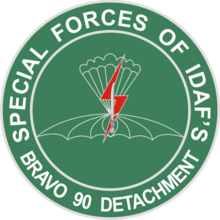
The Bravo Detachment 90 or (Satuan Bravo-90 / Satbravo-90) previously named Denbravo 90 is a counter-terrorism unit under the command of the Paskhas commander. The Paskhas Bravo Detachment 90 unit is tasked with carrying out intelligence operations, crippling enemy weaponry and installations in support of air operations, air piracy terror assault, and other operations in accordance with the policy of the TNI chief Commander. This unit is known as the youngest-formed Indonesian special operations unit within the Armed Forces (TNI). Newly formed in a limited setting within the Indonesian Air Force Military Forces Corps in 1990, Bravo was chosen as the name because of the meaning which is the best. The concept of formation refers to General Guilio Douchet's thought; "It is easier and more effective to destroy the opponent's air forces by destroying its base and its equipment on the ground rather than fighting in the air". Sat Bravo 90 is incorporated in the national Crisis Control Center ("Pusdalsis") BNPT consisting of a combination of special units, such as the Special Detachment 81 (Counter Terror) of the Army, Denjaka of the Navy, and Regiment I Gegana Brimob Corps from the National Police. Pusdalsis consisting of a combination of elite units of the joint forces of TNI and National Police (POLRI) is assigned as a troop handling terror to be sent when the activities of terrorism is happening such as aircraft hijacking.[5]
The motto of this Unit is in Sanskrit which is: Catya Wihikan Awacyama Kapala, that literally means: Faithful, Skilled and Successful.
Strength
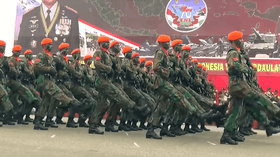
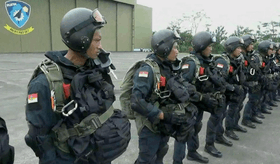
Recently, Paskhas has had a strength of around 7,300 personnel. Every Paskhas member must have para-commando qualification, plus special air aspects qualification based on his specialization. Every Paskhas member is also equipped with a white Commando dagger made in Germany. The orange beret and Commando dagger have become trademarks of this special force. Paskhas is also known for its light-green camouflage uniform called Commando Stripe, with a stretch-out straight motif like moss-covered wood, that was very famous during the Operation Seroja in East Timor. Previously the concept of Paskhas duty was as air force base defense troops (Defensive) only, but then the concept was developed by the TNI to be converted into more combined offensive and defensive troops force as the main Air Force infantry corps that can be deployed for assault and airborne operations.
There is a plan to expand the Paskhas into 10 or 11 battalions with twice as many personnel as what they had previously. Recently, the placement of Paskhas has still followed the organisation of TNI-AU weapon systems, in particular the combat and support-combat aeroplanes. In other words, wherever there is an Indonesian Air Force main airbase, ideally there is a Paskhas battalion as the airfield defence unit.
As a component Principal Command of the Indonesian Air Force, the Paskhas Corps is structured into the following in accordance with the provisions of presidential decree No. 62/ 2016:[6]
Commando Battalions

- Special/Elite Troops, which are :
- Bravo Detachment 90
- 1st, 2nd, and 3rd Paskhas Matra Detachments
- Air Parachute Commando Division consists of 9 Paskhas Commando Battalions which are under the structure of 3 Brigades. Which are:
- 1st Paskhas Para-Commando Wing Central :
- 461st Paskhas Commando Battalion
- 462nd Paskhas Commando Battalion
- 463rd Paskhas Commando Battalion
- 2nd Paskhas Para-Commando Wing East :
- 464th Paskhas Commando Battalion
- 465th Paskhas Commando Battalion
- 466th Paskhas Commando Battalion
- 3rd Paskhas Para-Commando Wing West :
- 467 Paskhas Commando Battalion
- 468 Paskhas Commando Battalion
- 469 Paskhas Commando Battalion
- 1st Paskhas Para-Commando Wing Central :
Air Defense Artillery Division
- 100th Paskhas Medium/Long Distance Missile Regiment/Wing :
- Regiment/Wing HQ
- 101 Missile Launcher Battalion
- 102 Missile Launcher Battalion
- 103 Missile Launcher Battalion
- 104 Missile Launcher Battalion
- 400th Paskhas Short Distance Missile Regiment/Wing :
- Regiment/Wing HQ
- 1st Mobile Air Defense Artillery Battalion, 1st Division Central Paskhas, Jakarta
- 2nd Mobile Air Defense Artillery Battalion, 2nd Division Paskhas, Makassar
- 3rd Mobile Air Defense Artillery Battalion, 3rd Division Paskhas, Medan
- 471 Air Defense Detachment, Halim Perdanakusuma Air Force Base, Jakarta
- 472 Air Defense Detachment, Hasanudin AFB, Makassar
- 473 Air Defense Detachment, Supadio AFB, Pontianak
- 474 Air Defense Detachment, Adisucipto AFB, Yogyakarta
- 475 Air Defense Detachment, Rusminnuryadin AFB, Pekanbaru
- 476 Air Defense Detachment, Suwondo AFB, Medan
- 477 Air Defense Detachment, Iswahyudi AFB, Madiun
- 478 Air Defense Detachment, Manuhua Husein Sastranegara AFB, Bandung
- 479 Air Defense Detachment, Manuhua AFB, Biak
Air Force Base Defense Regiment
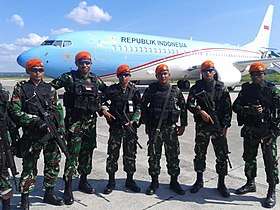
- Paskhas A.F.B.D Regt. HQ in Bandung;
- 1st Battalion 1st Paskhas Division
- 2nd Battalion 2nd Paskhas Division
- 3rd Battalion 3rd Paskhas Division
Combat Support Regiment
- Paskhas C.S.R Headquarters in Bandung;
- Regiment HQ
- Cavalry Armored Personnel Carrier Battalion
- Field Artillery Batt. (Light)
- Engineers Batt.
Admimistration Support Regiment
- Paskhas A.S.R Headquarters in Bandung
- Regiment HQ
- Electronics and Communication Batt.
- Medical Batt.
- Transportation and Ordnance Batt.
Korpaskhas Organization Structure
- 'Bravo Detachment 90 / Anti Terror' – Bogor
- Air Force Paskhas Escort and Ceremonial Service Regiment/ Satwalkol Paskhas' – Air Force Headquarters of Jakarta
- '100th Medium / Long Guided missile Regiment' – Bandung Paskhas Corps Command HQ (currently inactive, flagged for reactivation)
- Regiment/Wing HQ
- Paskhas Special Detachment Missile (Missile Detachment) 'Air Shield' for the National Palaces of Jakarta (Soon)
- 101st guided missile Battalion, National Air Defense Sector Command 1 (Soon)
- 102nd guided missile Battalion, National Air Defense Sector Command 2 (Soon)
- 103rd guided missile Battalion, National Air Defense Sector Command 3 (Soon)
- 104th guided missile Battalion, National Air Defense Sector Command 4 (Soon)
- 105th Maintenance Depot Battalion
- 'Combat Support Regiment' – Paskhas Corps Headquarters, Bandung
- Regiment/Wing HQ
- Armored Cavalry Battalion (Strength = Support Company and Headquarters Company)
- "A" Company become the strength of the Combat Support Battalion, 1st Division Central (I) Paskhas Corps.
- "B" Company become the strength of the Combat Support Battalion, 2nd Division East (II) Paskhas Corps.
- "C" Company become the strength of the Combat Support Battalion, 3rd Division West(III) Paskhas Corps.
- Field Artillery Battalion (Strength = Support Battery, Headquarters Battery and Target Acquisition Battery)
- "A" Battery become the strength of the Combat Support Battalion, 1st Division Central (I) Paskhas Corps.
- "B" Battery become the strength of the Combat Support Battalion, 2nd Division East (II) Paskhas Corps.
- "C" Battery become the strength of the Combat Support Battalion, 3rd Division West (III) Paskhas Corps.
- Engineers Battalion (Strength = Support Company and Headquarters Company)
- "A" Company become the strength of the Combat Support Battalion, 1st Division Central (I) Paskhas Corps.
- "B" Company become the strength of the Combat Support Battalion, 2nd Division East (II) Paskhas Corps.
- "C" Company become the strength of the Combat Support Battalion, 3rd Division West (III) Paskhas Corps.
- 'Administration Support Regiment' – Paskhas Corps HQ, Bandung
- Regiment/Wing HQ
- Medical Battalion (Strength = Support Company and Headquarters Company)
- "A" Company become the strength of the Administrative Assistance Battalion, 1st Division Central (I) Paskhas Corps.
- "B" Company become the strength of the Administrative Assistance Battalion, 2nd Division East (II) Paskhas Corps.
- "C" Company become the strength of the Administrative Assistance Battalion, 3rd Division West (III) Paskhas Corps.
- Communications (Signals) and Electronics Battalion (Strength = Support Company and Headquarters Company)
- "A" Company become the strength of the Administrative Assistance Battalion, 1st Division Central (I) Paskhas Corps.
- "B" Company become the strength of the Administrative Assistance Battalion, 2nd Division East (II) Paskhas Corps.
- "C" Company become the strength of the Administrative Assistance Battalion, 3rd Division West (III) Paskhas Corps.
- Transportation Battalion (Strength = Support Company and Headquarters Company)
- "A" Company become the strength of the Administrative Assistance Battalion, 1st Division Central (I) Paskhas Corps.
- "B" Company become the strength of the Administrative Assistance Battalion, 2nd Division East (II) Paskhas Corps.
- "C" Company become the strength of the Administrative Assistance Battalion, 3rd Division West (III) Paskhas Corps.
Paskhas Divisions
- 1st Paskhas Division Central (composite) – Jakarta
Consists of: 1st Matra (branch) Detachment, 1st Combat battalion with 6 companies, 1st base defence battalion with 7 companies (some still under formation), 1st Brigade/Wing with 3 battalions of commandos, and 1st Air Defense Artillery Regiment with 1 battalion and 3 detachments (some still under formation).
- 2nd Paskhas Division East (composite) – Makassar
Consists of: 2nd Matra (branch) Detachment, 2nd Combat battalion with 6 companies, 2nd base defense battalion with 7 companies (some still under formation), 2nd Brigade/Wing with 3 battalions of commandos, and 2nd Air Defense Artillery Regiment with 1 battalion and 3 detachments (some still under formation).
- 3rd Paskhas Division West (composite) – Medan
Consists of: 3rd Matra (branch) Detachment, 3rd Combat battalion with 6 companies, 3rd base defense battalion with 7 companies (some still under formation), 3rd Brigade/Wing with 3 battalions of commandos, and 3rd Air Defense Artillery Regiment with 3 detachments (some still under formation).
Hierarchy
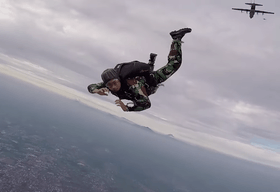
The Paskhas corps is the only corps-shaped organization for special qualified troops within the Indonesian Air Force even within the TNI. The status of the Paskhas corps is side by side with Kopassus, which are one of the main Special Forces officially recognized by the TNI and are directly responsible for operational purposes to the Commander of the National Armed Forces. This is because these two special forces organizations are Principal Commands ("KOTAMA") which are "Standing Own" status with lethal attack ability. Paskhas was born as a commando force from the time of its birth, they are deployed with a small unit to apprehend behind the opponent's defensive line and instantly pierce the enemy's core defenses. That is the main cause that this corps is trained in the method adopted from British SAS (through education in RPKAD educational center). The method of command education in the Kopassus tradition began in the 1950s within the Education and Training Center. Paskhas personnel are also allowed to continue wearing the prestigious orange beret in ceremonial or service uniforms during any official ceremonies.
The devotion of Paskhas continues with the demanding tasks imposed on the Air Force in general and Paskhas in particular. The devotion of the Paskhas can be seen from the presence of Paskhas who has never been absent in various forms of operations, both military war operations (OMP) and non-war military operations (OMSP) of Indonesia. Today, Paskhas has grown and developed into one of the mainstays and pride, which is believed to be the strength of the land forces of the Air Force. The organization of Paskhas is organized into two levels, namely the Operations Force Command of the Paskhas Corps of the Air Force abbreviated "Mako Korpaskhas" and the Executive Level. At the Mako Korpaskhas level consists of the leader echelon, the assistant echelon of staff, the service echelon, and the central executive echelon, underlying the other units below. While at the Executive Level oversees Wing I, Paskhas Wing II and Paskhas Wing III, Bravo Detachment 90, Branch (Matra) Detachment, Air defense detachment and the Paskhas training and education center.
Paskhas also intends to bring in another tactical vehicle like the domestically produced "Dirgantara Military Vehicle" (DMV) made by PT DI which proved reliable and has been used by the elite Paskhas Bravo Detachment 90 unit.
Air defense
The orange beret corps has been also reinforced with the arrival of 200 surface-to-air QW(QianWei)-3 surface missiles. Manpad QW-3 missiles (expected addition of about 300 units again for Pam Sat Radar) QW-3 missiles are equipped with semi-active laser guidance trackers, suitable for fighter and other missiles at low altitudes of up to 8 km. It has a weight of 13 kg and a maximum speed of 750 km / hour. This weapon is used to replace Triple gun made by Hispano Suiza (Switzerland) in the 1950s and DSHK 12.7 mm. Also a few moments ago Pindad tested the weapon to be rehabilitated to be used as heavy weapons for Paskhas ground forces units.
Paskhas is also working on bringing in a short-range PSU battery of 35 mm caliber Oerlikon Contraves to Air defense composite model point that is integrated between missiles, cannons, radar and tactical command posts. This weapon has been using the most advanced technology and has been used by many European countries. According to the plan, this PSU weapon will be placed in the 10th Main Air Force Base. One of the other major advantages to this 35 mm 35mm Oerlikon PSU is its ability to be mobilized with Hercules aircraft. The Air Force purchased in 2017 a set of 10 batteries of the NASAMS-2 system to suit their requirements for a medium-range missile / JSe substitute for the S-75 / SA-2 Guideline SAM, which was introduced to the service in the 1960s, Going forward with the arrival of the 35mm aerophonic contraves gun, the addition of the number of QW-3 manpad missiles and some good triple gun cannon units. The National Air defense forces command (Kohanudnas) also plan to revive the Medium-Long Missile Wing, to be composed of several artillery groups/battalions of air defense artillery guns and within each Paskhas wing 2 air defense missile artillery groups/battalions, each composed composed of a HQ unit, a number of AAA gun or missile (MANPAD or distance missile) batteries, a replacement battery and a target acquisition battery.
In the future development of Paskhas, the current PSU weaponry in service or are being commissioned are:
- Oerlikon Contraves 35 mm (expected 55 units replacement Triple Gun 1950)
- Manpad QW-3 individual missiles (expected to add about 300 more units to Pam Sat Radar)
- NASAMS 2 Medium Distance Missile / JSe Substitute missile for the S-75 / SA-2 Guideline (aimed to arm 7–10 batteries for a potential total of 32-34 batteries, ordered 2017)
Individual and vehicle weaponry
Paskhas is now seeking to replace Pindad SS1 individual weapons to SiG-552 or Pindad SS2. Especially to prepare command battalions such as the 461st commando battalion and 469th commando battalion as assault troops, then in each team in each postal battalion will be equipped with SS2-V1 with Pindad 40mm Grenade Launcher and Squad Automatic Weapon sub-machine guns such as FN Minimi (Automatic Weapon Team). While in the assistance company will be equipped with SMB (Heavy Machine Guns) DShk-38 which is designed as a weapon for short-range land and air objectives. SMB is commonly used by cavalry and infantry units. In the cavalry unit, DShK has become the standard placed on various turrets of the MBT (Main Battle Tank), even light tanks, APCs and Rantis pick ups. In the infantry units, it is natural that DShK is operated with a two-wheeled special case, similar to a cannon model. Thus the SMB is easily moved, carried or moved with the help of a hook on a military jeep or truck.
Combat qualifications
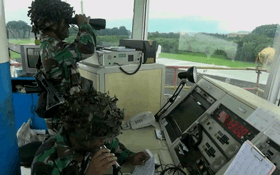
Paskhas personnel are an integral part of the TNI-AU, having their own speciality. Paskhas personnel have the qualifications and special ability to protect, defend and operate airfield facilities. The TNI-AU has high-technology weapons systems are a vital object for enemy forces to destroy.
The basic qualification for all Paskhas personnel has been "para-commando". Other qualifications are added based on his speciality. As a Combat Control team (CCT), they have combat free-fall ability, scuba diving, and combat climber. CCT must be able to infiltrate from three media aspects (sea, air, land). Beside that, this team's personnel must have one of the air aspect specialisations, such as: Air Traffic Controller (PLLU), Meteorology (Meteo), Electronic-Communication (Komlek), Combat Field Engineer (Zeni), Intelligence, Fire Fighter (PK), Ground handling, Petroleum affairs (Permi), and Combat-Health affairs (Keslap). For free-fall qualification, they must be brave enough to jump from high altitude and open the parachute at minimum altitude. The airborne technique that used was HALO (High Altitude Low Opening) or HAHO (High Altitude High Opening), with jumps around 20,000 feet (6 km; 4 mi) above sea level.
CCT also has qualifications to direct fighter planes to bomb or shoot targets from the ground (Ground Forward Air Control/GFAC). This role is very important in battle because air support must be precisely on time and target. Paskhas personnel must be able to use IT and to communicate with multimedia tools. Besides that, they are also required to have combat-intelligence ability as a collection board (Bapul) for higher command, or any other side that is needed. For example, they inform about flight facilities before plane arrive, visibility, wind speed and direction, temperature and air humidity also height and cloud type. This has been a very important factor in bombing targets and for the airborne process. All the personnel also have training as a Combat-Field Engineer (include pioneer, rope, etc.), Air Field Control (Dallan) to operate flight in some aerodrome, or Air Traffic Control (PLLU), which can control flight traffic in their sector area. Petroleum Affairs (Permi) must know and test the oil standard that fulfill the conditions and the way to fill the oil into the aeroplane.
Because Paskhas operate as commando forces, they rarely involve many personnel in their operation. Paskhas have also used unusual calls when they were doing combat mission, such as detachment, team and unit to differentiate them from regular forces.
Specialization
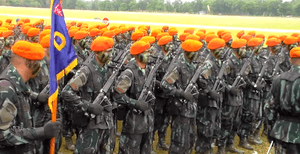
The Paskhas Corps is divided into several Specializations which are:
- Training and Education Center (Pusdiklat), is responsible for carrying out the training of Paskhas abilities through the implementation of Education, Exercise, Research, Testing and Development of Tactics and Procedures to carry out the task of seizing objectives and defense of Air Force Strategic Objects, Air Defense, Special Operations and Typical Air Force Military Operations.
- Anti Terror (Bravo Detachment 90), is responsible for carrying out Intelligence Operations, Airborne Aspects of Terror Countermeasures Operations and other Special Operations in Air Force Military Operations under the policy of the TNI chief Commander.
- Branch Detachment (Detasemen Matra), is in charge of carrying out combat control operations, base controls, combat Search and Rescue, and Jumpmaster trainings for Paskhas personnel.
- Air Defense Detachment (Detasemen Hanud), is part of the Paskhas air defense detachment which is in charge of carrying out air defense operations as part of the national air defense system and other military operations according to the policy of the TNI chief Commander within the Air Force organization.
- Para-Commandos (Parako), are Infantry Commandos in a Battalion size tasked with carrying out Paskhas main operational combat tasks such as target assault operations and defense operations of the Indonesian Air Force's strategic objects during combat and peace-time situations
- Combat Support Regiment (Resimen Banpur), serves as an assistance force for combatants especially Commando troops who are usually deployed to the frontline of battle, either in the form of combat or administrative aid. This regiment consists of Cavalry Battalion, Engineers Battalion, Artillery Battalion, Medical Battalion, Electronical and Communication Battalion, and Transportation Battalion.
Current structure

- 1st Division Central /Harda Marutha (composite) – Jakarta
- Division HQ
- 461 Commando Battalion /Cakra Bhaskara – Jakarta
- 463 Commando Battalion /Trisula – Madiun
- 467 Commando Battalion /Hardha Dedali – Jakarta
- 1st Matra Detachment /Naga Pasa – Jakarta
- 1st Air Base Defense Group
- 471 Air Defence Detachment /Kunta Wijayandanu – Jakarta
- 474 Air Defence Detachment /Kunta Wijayandanu – Jogjakarta
- 461 C Rifles Company /Paskhas – Subang
- 467 C Rifles Company /Paskhas – Bogor
- 2nd Division East/Harda Marutha (composite) – Makassar
- Division HQ
- 464 Commando Battalion /Nanggala – Malang
- 466 Commando Battalion /Pasopati – Makassar
- 468 Commando Battalion /Sarotama – Biak
- 2nd Matra Detachment /Naga Pasa – Malang
- 2nd Air Base Defense Group
- 472 Air Defence Detachment /Kunta Wijayandanu – Makassar
- 466 C Rifles Company /Paskhas – Makassar
- 3rd Division West /Harda Marutha (composite) – Medan
- Division HQ
- 462 Commando Battalion /Pulanggeni – Pekanbaru
- 465 Commando Battalion /Brajamusti – Pontianak
- 469 Commando Battalion /Pancawara – Medan
- 3rd Air Base Defense Group
- 473 Air Defence Detachment /Kunta Wijayandanu – Pontianak
- 469 C Rifles Company /Paskhas – Banda Aceh
- 469 B Rifles Company /Paskhas – Lhoksumawe
- Paskhas Education and Training Center (composite) – Bandung
- Air Defence Education and training unit (Satdik Hanud)
- Special Education unit (Satdik Sus)
- General education and training unit (Satdik Matra): tasked for implementing Jumpmaster courses, paratrooper courses, etc.
- Combat Support Education unit (Satdik Banpur)
- Ground Warfare Education unit (Satdik Purrat)
Operations
Operation Trikora
During Operation Trikora, the Paskhas corps then "PGT AURI" in the Trikora operations deployed a total of 532 paratroopers – the largest number of military personnel operationally deployed to West Papua. The number of personnel from TNI, National Police (Mobile Brigade) and volunteers taking part amounted to 1,154 personnel with 216 deaths / lost and 296 captured. On 25 April 1962, during the operation of Banteng Ketaton as many as 40 PGT troops under the leadership of Sgt. Maj. J. Picaulima was deployed for the first time in West Irian in Fak-Fak area as well as the 39 PGT troops in Kaimana on 26 April 1962 did well. On 11 May 1962, PGT troops under the leadership of 1st Lieutenant Manuhua conducted a jump in Sorong during Operation Serigala.
One of the heroic and historic stories is the event of the National flag hoisting for the first time on a hill named Cendrawasih, in West Papua, conducted by Paskhas members at the initiative of Sergeant M.F. Mengko. On 19 May 1962, a total of 81 Paskhas paratroopers departed from Pattimura Air Base, Ambon, on board a C-130 Hercules transport plane piloted by Major (U) T.Z Abidin towards the target of a parachuting area around Wersar Village, Teminabuan District. In the early morning they were deployed just above the headquarters of the Dutch army. Suddenly close combat was unavoidable. Dutch troops which were sleeping was in shock because there are troops of Paskhas deployed right in their bases, while Paskhas soldiers also did not expect to be deployed in the Dutch base, rather being deployed in tea plantations. This heroic action resulted in the death of 53 Paskhas parachute commandos including the platoon commander 2nd Lieutenant Suhadi. To commemorate the historic event in the area around Teminabuan in Sorong, West Papua, a monument that is named Tugu Merah Putih (Red and White monument) was later built on the site of the battle.[7]
Other operations
- Operation Dwikora
- Operation Seroja
- Operation Trisula
- Rebel assault operations
Peacekeeping Missions
- Garuda Contingent in Vietnam
- XIV Garuda Contingent under UNPROFOR in Yugoslavia
- XIV A-B Garuda Contingent in Bosnia
- XVII Garuda Contingent under OKI in the Philippines
- XXIII Garuda Contingent in Lebanon
See also
- Indonesian Air Force
- Kopassus – Indonesian Army special forces.
- Kopaska – Indonesian Navy tactical Frogman commando.
- Denjaka – Indonesian Joint Navy-Marine special forces.
References
- ↑ Sutrisno. "Marsekal TNI Suryadi Suryadarma" Departemen Pendidikan dan Kebudayaaan, Jakarta, 1985.
- ↑ Sesuai keputusan MEN/PANGAU No.54 Tahun 1967, tanggal 12 Oktober 1967.
- ↑ http://weaponstechnology.blogspot.co.id/2011/06/
- ↑ http://paskhas.mil.id/sat-paskhas-3
- ↑ "Latih Kesiapan Antiteror di Gulkonsis VI", Remigius Septian, COMMANDO edisi 6 vol. XII 2016, p. 28, 2016
- ↑ "Presidenial Decree No. 62/ 2016" (PDF). kemendagri.go.id. 14 July 2016. Retrieved 10 January 2018.
- ↑ http://weaponstechnology.blogspot.co.id/2011/06/